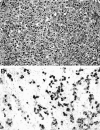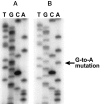Genetic, immunohistochemical, and clinical features of medullary carcinoma of the pancreas: A newly described and characterized entity
- PMID: 10793075
- PMCID: PMC1876921
- DOI: 10.1016/S0002-9440(10)65035-3
Genetic, immunohistochemical, and clinical features of medullary carcinoma of the pancreas: A newly described and characterized entity
Abstract
Medullary carcinomas of the pancreas are a recently described, histologically distinct subset of poorly differentiated adenocarcinomas that may have a unique pathogenesis and clinical course. To further evaluate these neoplasms, we studied genetic, pathological, and clinical features of 13 newly identified medullary carcinomas of the pancreas. Nine (69%) of these had wild-type K-ras genes, and one had microsatellite instability (MSI). This MSI medullary carcinoma, along with three previously reported MSI medullary carcinomas, were examined immunohistochemically for Mlh1 and Msh2 expression, and all four expressed Msh2 but did not express Mlh1. In contrast, all of the medullary carcinomas without MSI expressed both Msh2 and Mlh1. Remarkably, the MSI medullary carcinoma of the pancreas in the present series arose in a patient with a synchronous but histologically distinct cecal carcinoma that also had MSI and did not express Mlh1. The synchronous occurrence of two MSI carcinomas suggests an inherited basis for the development of these carcinomas. Indeed, the medullary phenotype, irrespective of MSI, was highly associated with a family history of cancer in first-degree relatives (P < 0.001). Finally, one medullary carcinoma with lymphoepithelioma-like features contained Epstein-Barr virus-encoded RNA-1 by in situ hybridization. Therefore, because of medullary carcinoma's special genetic, immunohistochemical, and clinical features, recognition of the medullary variant of pancreatic adenocarcinoma is important. Only by classifying medullary carcinoma as special subset of adenocarcinoma can we hope to further elucidate its unique pathogenesis.
Figures






References
-
- Hruban RH, Wilentz RE: The pancreas. Modern Surgical Pathology. Edited by N Weidner, RJ Cote, S Suster, LM Weiss. Philadelphia, Saunders, 2000
-
- Solcia E, Capella C, Klöppel G: Tumors of the pancreas. Atlas of Tumor Pathology, Third Series, Fasicle 20. 1997, Armed Forces Institute of Pathology, Washington, DC,
-
- Cubilla A, Fitzgerald PJ: Morphological patterns of primary nonendocrine human pancreas carcinoma. Cancer Res 1975, 35:2234-2248 - PubMed
-
- Goggins M, Offerhaus GJ, Hilgers W, Griffin CA, Shekher M, Tang D, Sohn TA, Yeo CJ, Kern SE, Hruban RH: Pancreatic adenocarcinomas with DNA replication errors (RER+) are associated with wild-type K-ras and characteristic histopathology. Poor differentiation, a syncytial growth pattern, and pushing borders suggest RER+. Am J Pathol 1998, 152:1501-1507 - PMC - PubMed
-
- Lynch HT, Smyrk TC, Lynch JF: Overview of natural history, pathology, molecular genetics, and management of HNPCC (Lynch syndrome). Int J Cancer 1996, 69:38-43 - PubMed
Publication types
MeSH terms
Substances
Grants and funding
LinkOut - more resources
Full Text Sources
Medical
Miscellaneous

